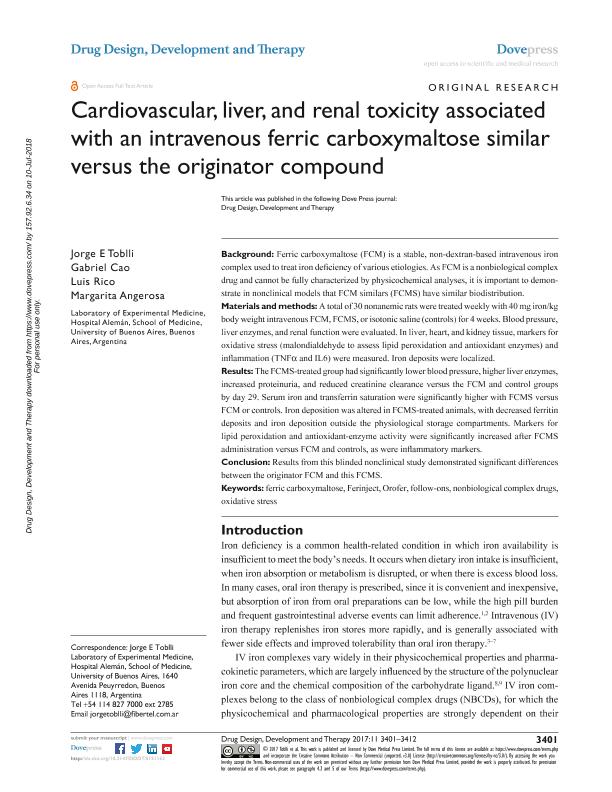Mostrar el registro sencillo del ítem
dc.contributor.author
Toblli, Jorge Eduardo

dc.contributor.author
Cao, Gabriel Fernando

dc.contributor.author
Rico, Luis
dc.contributor.author
Angerosa, Margarita

dc.date.available
2018-12-18T20:39:23Z
dc.date.issued
2017-11
dc.identifier.citation
Toblli, Jorge Eduardo; Cao, Gabriel Fernando; Rico, Luis; Angerosa, Margarita; Cardiovascular, liver, and renal toxicity associated with an intravenous ferric carboxymaltose similar versus the originator compound; Dove Medical Press Ltd.; Drug Design, Development and Therapy; 11; 11-2017; 3401-3412
dc.identifier.issn
1177-8881
dc.identifier.uri
http://hdl.handle.net/11336/66709
dc.description.abstract
Background: Ferric carboxymaltose (FCM) is a stable, non-dextran-based intravenous iron complex used to treat iron deficiency of various etiologies. As FCM is a nonbiological complex drug and cannot be fully characterized by physicochemical analyses, it is important to demonstrate in nonclinical models that FCM similars (FCMS) have similar biodistribution. Materials and methods: A total of 30 nonanemic rats were treated weekly with 40 mg iron/kg body weight intravenous FCM, FCMS, or isotonic saline (controls) for 4 weeks. Blood pressure, liver enzymes, and renal function were evaluated. In liver, heart, and kidney tissue, markers for oxidative stress (malondialdehyde to assess lipid peroxidation and antioxidant enzymes) and inflammation (TNFα and IL6) were measured. Iron deposits were localized. Results: The FCMS-treated group had significantly lower blood pressure, higher liver enzymes, increased proteinuria, and reduced creatinine clearance versus the FCM and control groups by day 29. Serum iron and transferrin saturation were significantly higher with FCMS versus FCM or controls. Iron deposition was altered in FCMS-treated animals, with decreased ferritin deposits and iron deposition outside the physiological storage compartments. Markers for lipid peroxidation and antioxidant-enzyme activity were significantly increased after FCMS administration versus FCM and controls, as were inflammatory markers. Conclusion: Results from this blinded nonclinical study demonstrated significant differences between the originator FCM and this FCMS.
dc.format
application/pdf
dc.language.iso
eng
dc.publisher
Dove Medical Press Ltd.
dc.rights
info:eu-repo/semantics/openAccess
dc.rights.uri
https://creativecommons.org/licenses/by-nc-sa/2.5/ar/
dc.subject
Ferinject
dc.subject
Ferric Carboxymaltose
dc.subject
Follow-Ons
dc.subject
Nonbiological Complex Drugs
dc.subject
Orofer
dc.subject
Oxidative Stress
dc.subject.classification
Patología

dc.subject.classification
Medicina Básica

dc.subject.classification
CIENCIAS MÉDICAS Y DE LA SALUD

dc.title
Cardiovascular, liver, and renal toxicity associated with an intravenous ferric carboxymaltose similar versus the originator compound
dc.type
info:eu-repo/semantics/article
dc.type
info:ar-repo/semantics/artículo
dc.type
info:eu-repo/semantics/publishedVersion
dc.date.updated
2018-10-23T19:45:00Z
dc.journal.volume
11
dc.journal.pagination
3401-3412
dc.journal.pais
Nueva Zelanda

dc.journal.ciudad
Auckland
dc.description.fil
Fil: Toblli, Jorge Eduardo. Consejo Nacional de Investigaciones Científicas y Técnicas; Argentina. Hospital Alemán; Argentina. Universidad de Buenos Aires; Argentina
dc.description.fil
Fil: Cao, Gabriel Fernando. Consejo Nacional de Investigaciones Científicas y Técnicas; Argentina. Hospital Alemán; Argentina. Universidad de Buenos Aires; Argentina
dc.description.fil
Fil: Rico, Luis. Hospital Alemán; Argentina. Universidad de Buenos Aires; Argentina
dc.description.fil
Fil: Angerosa, Margarita. Hospital Alemán; Argentina. Universidad de Buenos Aires; Argentina
dc.journal.title
Drug Design, Development and Therapy
dc.relation.alternativeid
info:eu-repo/semantics/altIdentifier/doi/https://dx.doi.org/10.2147/DDDT.S151162
dc.relation.alternativeid
info:eu-repo/semantics/altIdentifier/url/https://www.dovepress.com/cardiovascular-liver-and-renal-toxicity-associated-with-an-intravenous-peer-reviewed-article-DDDT
Archivos asociados
